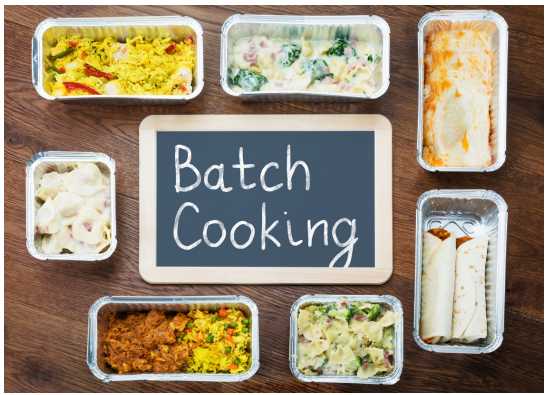Making life easier in the kitchen
Source : Nutriactis/Rouen-Normandie hospital
Summary
- How to Shop
- How to Prepare
- How to cook
- A few additional tips
With our increasingly busy lives and often hectic days, it can be hard to find the time and motivation to cook healthy and balanced meals! We’re here to help you with a few cooking tips.
This article is here to help you determine your strategies for saving time in the kitchen and eating a healthier, more balanced diet.

How to Shop
Even before you start cooking, there are already time-saving tips for healthier eating.
Plan
First of all, planning is key! In fact, taking the time to plan your meals in advance will enable you to draw up a shopping list that will save you time when shopping. This list will give you a greater control over your purchases, so that you don’t run out of ingredients and limit the risk of having to improvise a meal at the last minute, which generally results in an unbalanced meal. Don’t hesitate to draw up a list of your favorite dishes that you can make on a regular basis, along with an estimate of the time needed to prepare them.
Adapt
When planning your meals, be realistic about the time you want to allocate in preparing them. So adapt your menu to your schedule. To do this, choose recipes with few ingredients and ingredients that are easy to cook (see below). And don’t hesitate to look in your fridge, so that you can use any leftover ingredients in your next recipes.
Optimize
To save time and make life easier, consider using the same ingredients for several recipes. Why not use red beans in a rice salad and in chili the next day, or switch from chicken curry to fajitas?
Think about using ingredients that require little preparation in your recipes, for example:
- Frozen products: unprepared, unprocessed frozen products (without seasoning) have no added ingredients, and freezing preserves not only their flavor but also their vitamins and minerals, which is why they are good for your health. Using frozen products also helps reduce food waste. For example, you can buy frozen herbs: onions, shallots, parsley, coriander…
- If you don’t have a freezer, you can opt for pre-cut or canned products. When using canned food, remember to choose unprepared, unprocessed products first (without seasoning), and rinse food before consumption to remove excess salt.
How to Prepare
Here are a few tips that can be used to simplify meal preparation and save time:
- Wash all the fruit and vegetables you buy.
- Skip the peeling: zucchinis, cucumbers, eggplants, potatoes… many foods don’t need peeling if they’ve been properly washed.
- Cut all the fruit and vegetables you’ve bought in advance and place them in a closed container in the fridge. You can add a dash of lemon juice to prevent the food from oxidizing (browning) and losing its bright color and appetizing appearance.

If you don’t know which meal to prepare, choose foods that are rapidly perishable, and keep foods with the best or longest shelf life for other days.
How to cook
Now it’s time to start cooking your meal. To limit the cooking time, it’s important to choose the right cooking method.
Here’s an overview of cooking methods:

To save time, you can choose the fastest cooking mode whenever it is possible.
Microwave oven:
The microwave is one of the fastest cooking methods available. You can use it for a variety of foods, such as vegetables, fish or fruit. Simply place them in a microwave-safe dish, add a little water, lemon juice or olive oil as required, and cover with cling film. Microwave cooking is also an excellent way of preserving vitamins and minerals.


Passive cooking modes:
You can also opt for passive cooking modes such as the oven or pressure cooker, which require little supervision and allow you to do other things at the same time.
Cut into small pieces:
Whether vegetables, fish, meat or fruit, the smaller the pieces, the faster they cook.

Reusing is the key
Use the same utensils: “One pot” is the term used to describe a recipe that uses a single container to make a complete dish. For example, you can prepare a “one-pot pasta”:
- Cook chopped onions, peppers, carrots and chicken in a frying pan or saucepan until golden brown
- Add your choice of raw pasta, tomatoes and water
- Cook according to the time indicated for your pasta
- Season with salt and pepper
- Add fresh basil before serving
Now all you have to do is enjoy !!


Cooking large quantities:
Cooking large quantities generally saves time when preparing meals (optimizing cooking time, utensils used, dishes...). So when you’re cooking, always remember to make extra portions. You can either freeze them, eat them the next day or use them to create other dishes.
Batch cooking
Batch cooking is a method of meal preparation that involves cooking a large quantity of dishes for the week all at once. Here are some batch cooking tips:
- Prepare your recipe bases: carbohydrates, legumes, etc.
- Prepare your recipes according to your stocks. Do you have an abundance of tomatoes in your fridge? Why not make a tomato/goat tart, a Bolognese sauce and a mixed salad.
- Cook several items at the same time: you can bake the pie while the Bolognese sauce and the rice for the mixed salad are cooking… Always remember to start with the item that takes the longest cooking times!
- Optimize cooking methods: use all cooking methods to further reduce your time in the kitchen (oven, steam, microwave, etc.).
- Ideally, prepare your batch cooking session the day before to anticipate certain steps, such as defrosting products in the fridge, soaking legumes…


- Think of gathering all the vegetables from your batch cooking session to make a vegetable pan! And one more recipe!
- Carbohydrates, vegetables, legumes, meat, fish… remember to vary the food you use so you do not get bored, and to give yourself endless combinations and possibilities.
- Choose dishes that are easy to reheat, and forget about minute cooking.
- Create a list of recipes for your batch cooking
A few additional tips

Conclusion
We hope this newsletter has given you a few tips to make your life easier in the kitchen. The aim is, without much effort, to limit the purchase of ready-made meals and promote more economical, healthier eating. These tips also help to limit waste and thus protect the planet.

-
Making life easier in the kitchen
pdf – 12 MB
 You might be interested in these articles
You might be interested in these articles